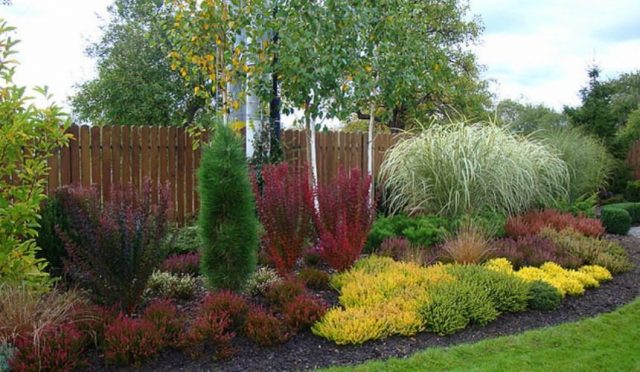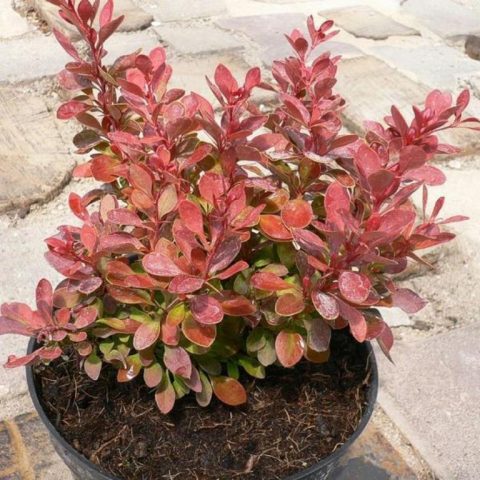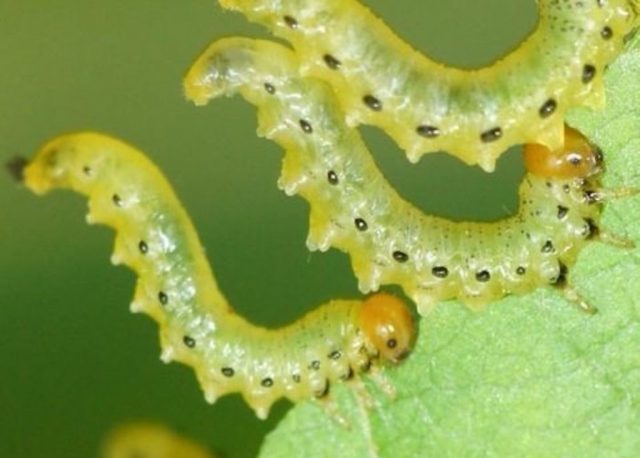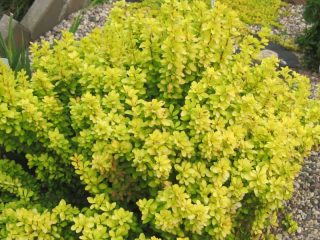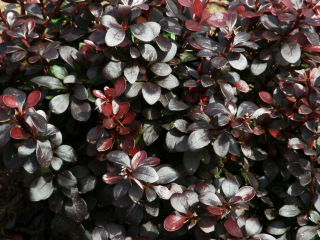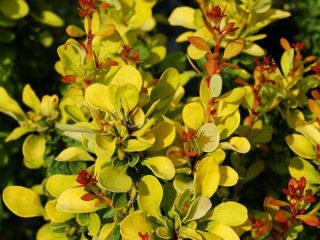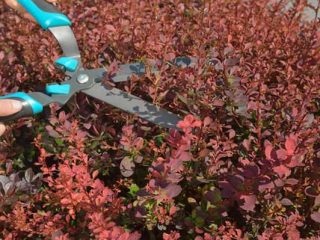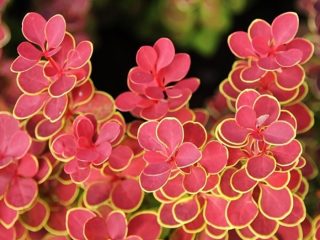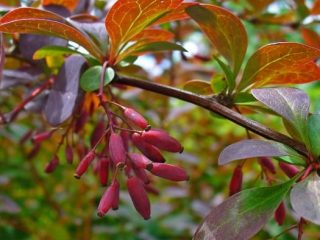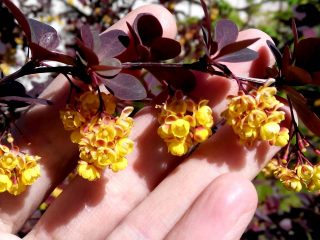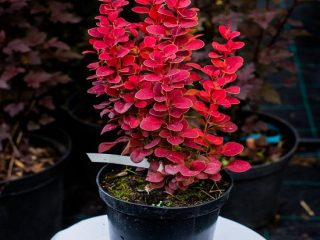Content
Barberry Harlequin is an unpretentious, ornamental shrub from the barberry family. This species is very popular among gardeners for its beautiful appearance and useful qualities. The variegated, graceful shrub is widely used in landscape design. Due to its variegated foliage, it is used to frame flower beds and mixborders.
Description of barberry Harlequin
Harlequin barberry was found on the mountain slopes of Japan in 1864, but it gained European popularity relatively recently. Getting acquainted with the Thunberg Harlequin barberry must begin with a description:
- The variety is medium-sized and slow-growing. The height of an adult plant reaches up to 2 m, and the annual growth is 10 cm in height and width;
- the crown is wide, spreading;
- purple leaf plate, with white specks, changes color to snow-white in the sun. With the arrival of autumn it turns golden amber or red;
- in early May, small golden inflorescences appear on the bush;
- flowering is abundant, lasts about 1 month;
- after flowering, bright red fruits are formed that remain on the branches all winter;
- dark brown shoots have sharp thorns that cause difficulty in care;
- Fruiting occurs 3 years after planting.
Barberry Harlequin in landscape design
Harlequin barberry is used in single and group plantings, to create tree and shrub compositions, mixborders, as well as to create borders and green hedges. The variegated shrub goes well with conifers and other varieties of barberry.
Barberry Harlequin has found wide application for landscaping city parks and squares, intra-block, school and city courtyards.
Planting and caring for Harlequin barberry
Before planting, it is necessary to take into account the preferences of the plant. Barberry Harlequin prefers:
- acidic and slightly alkaline soil;
- bright and ventilated place;
- regular watering;
- timely feeding;
- pruning
Preparing seedlings and planting area
It is better to purchase a Harlequin barberry seedling with a closed root system. When purchasing, you should pay attention to the shoots. They must be leafless and healthy looking without mechanical damage.
The barberry root system should not come out of the drainage holes; if this happens, then the plant is old and the likelihood of survival is significantly reduced.
When purchasing a seedling with an open root system, first of all, inspect the roots. They should not have a dark appearance, be dry and rotten. Before planting, the root system of the seedling is trimmed and soaked in warm water for about 1-2 hours.
It is better to prepare the planting site a month before planting. To do this, the soil is dug up on the bayonet of a shovel, organic and mineral fertilizers are added, spilled and covered with polyethylene. Before planting, the soil is dug up again.
Planting barberry Thunberg Harlequin
For good growth and development, the seedling must be planted correctly. For this:
- Harlequin barberry seedlings are planted in the autumn, a month before the onset of frost.
- Dig a hole 60x60 cm.
- If preliminary preparation of the hole has not been carried out, the extracted soil is mixed with compost, humus or rotted manure.
- Broken brick, expanded clay or pebbles are laid on the bottom in a layer of 15 cm.
- Prepared, fertile soil is laid on top.
- The seedling is placed in the center of the planting hole and carefully covered with earth, compacting each layer, trying not to leave any air space.
- After planting, the soil is compacted again, watered generously and mulched.
- To prevent the plant from becoming deformed as it grows, it is tied to a peg.
Watering and fertilizing
Harlequin barberry is a drought-resistant crop, so watering is carried out only in dry summers. To do this, pour at least 1 bucket of warm water under the root, 2 times a month. After watering, the soil is loosened and mulched. Suitable mulch is: dry straw, leaves and sawdust. Mulch will retain moisture, protect against sunburn and, over time, become an additional fertilizer.
For good growth and development, Harlequin barberry needs fertilizer. To do this, you can use humus, compost, and complex mineral fertilizers. Fertilizing is applied 3 times per season:
- during the growing season;
- at the moment of flowering;
- during fruit formation.
If the seedling is purchased with a closed root system, the first fertilizing is applied 2 years after planting.
Trimming
In order for the plant to have a decorative appearance and little pain, it needs timely pruning. Harlequin barberry requires 3 types of pruning:
- shaping - carried out in the fall to give the bush the desired shape;
- sanitary – in the spring, shoots that have not overwintered and are removed are removed;
- rejuvenating - remove all old shoots every 7 years.
Preparing for winter
Barberry Harlequin is a cold-resistant crop that can withstand temperatures down to -30 degrees. But in the first 2 years, young seedlings may suffer from severe frosts, so in order not to lose the variety, they must be covered.
In order to protect the root collar, the tree trunk circle is mulched with straw, leaves or spruce needles. To cover the above-ground part, the shoots are collected in a bundle, wrapped in spunbond and secured with a rope or metal bracket.
After the end of spring frosts, the shelter is removed. If you are too late, the Harlequin barberry will sap and die.
Reproduction
Barberry Harlequin reproduces in several ways:
- seeds;
- cuttings;
- dividing the bush;
- root shoots.
When propagating from seeds, the probability of germination is very low, so this method is not suitable for beginning gardeners.
Cuttings are the simplest and least labor-intensive method of propagation. To propagate Harlequin barberry by cuttings, you need:
- In June, cut cuttings 10-15 cm long from the side shoots.
- The lower leaves are removed, the upper ones are shortened by ½ length.
- Planting material is soaked for 2 hours in the preparation “Kornevin” or “Epin”.
- The cuttings are planted in a sand-peat mixture and covered with a glass cap to create a favorable microclimate.
- Once a day, the cover is removed for ventilation and watering.
- After rooting, new leaves will begin to appear on the cuttings, and it will begin to grow.
- When the plant grows a root system and becomes stronger, it is transplanted into a container with nutritious soil.
- In a year, the young barberry will be ready to be transplanted to a permanent location.
Diseases and pests
Barberry Harlequin has strong immunity to many diseases and pests. But if the rules of care are not followed, the following may appear on the plant:
- aphid;
- powdery mildew;
- sawfly;
- bacterial cancer.
You can determine the diseases of the Harlequin barberry from the photo.
Aphid - a small insect that appears on shoots and leaves. If not treated in a timely manner, the pests suck out the sap, which leads to drying out of the young shoots. Treatment consists of treating the bush with pepper or soap solution. In case of mass infection, the plant is treated with insecticides.
Powdery mildew – the disease can be identified by a white coating on the leaves. Powdery mildew often appears at high humidity and air temperature. It is difficult to completely get rid of the disease, so at the first signs the plant is sprayed with fungicides.
Bacterial cancer - a dangerous disease that cannot be cured. The first signs of the disease:
- leaf wilting and curling;
- Red-colored ulcers appear on young petioles;
- necrotic spotting on leaves and shoots;
- Darkened conductive bundles are visible on the cut of the branch.
If a disease is detected, all affected shoots are removed, and undamaged shoots are treated with Bordeaux mixture.
Barberry sawfly – the insect is a caterpillar that quickly eats the entire plant.To get rid of pests, the bush is treated with the drug “DNOC”.
Conclusion
The variegated Harlequin barberry is ideal for decorating a garden plot. In order for the shrub to grow well, develop and have a well-groomed appearance, it is necessary to follow the rules of care and timely carry out preventive measures against diseases and pests.

